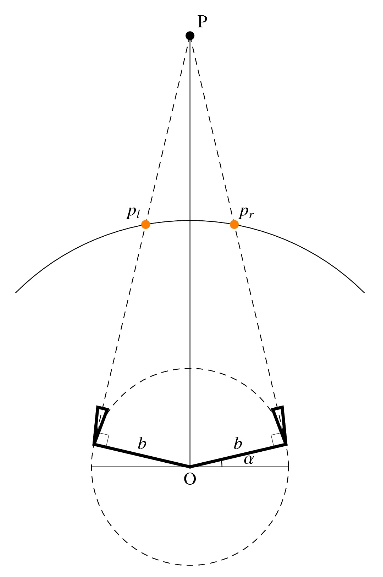Le cinéma omnistéréo ou l’art d’avoir des yeux tout le tour de la tête
these » Ph.D.Vincent Chapdelaine-Couture
Tags: cinéma , immersion , omnistéréo , panorama , perception- , psychophysique , reconsctruction active , stéréo
Date : 2012-04-24
Abstract
 This thesis deals with aspects of shooting, projection and perception of stereo panoramic cinema, also called omnistereo cinema. It falls largely in the field of computer vision, but it also in the areas of computer graphics and human visual perception. Omnistereo cinema uses immersive screens to project videos that provide depth information of a scene all around the spectators. Many challenges remain in omnistereo cinema, in particular shooting omnistereo videos for dynamic scenes, polarized projection on highly reflective screens making difficult the process to recover their shape by active reconstruction, and perception of depth distortions introduced by omnistereo images. Our thesis addressed these challenges by making three major contributions. First, we developed the first mosaicing method of omnistereo videos for stochastic and localized motions. We developed a psychophysical experiment that shows the effectiveness of the method for scenes without isolated structure, such as water flows. We also propose a shooting method that adds to these videos foreground motions that are not as constrained, like a moving actor. Second, we introduced new light patterns that allow a camera and a projector to recover the shape of objects likely to produce interreflections. These patterns are general enough to not only recover the shape of omnistereo screens, but also very complex objects that have depth discontinuities from the viewpoint of the camera. Third, we showed that omnistereo distortions are negligible for a viewer located at the center of a cylindrical screen, as they are in the periphery of the visual field where the human visual system becomes less accurate.
This thesis deals with aspects of shooting, projection and perception of stereo panoramic cinema, also called omnistereo cinema. It falls largely in the field of computer vision, but it also in the areas of computer graphics and human visual perception. Omnistereo cinema uses immersive screens to project videos that provide depth information of a scene all around the spectators. Many challenges remain in omnistereo cinema, in particular shooting omnistereo videos for dynamic scenes, polarized projection on highly reflective screens making difficult the process to recover their shape by active reconstruction, and perception of depth distortions introduced by omnistereo images. Our thesis addressed these challenges by making three major contributions. First, we developed the first mosaicing method of omnistereo videos for stochastic and localized motions. We developed a psychophysical experiment that shows the effectiveness of the method for scenes without isolated structure, such as water flows. We also propose a shooting method that adds to these videos foreground motions that are not as constrained, like a moving actor. Second, we introduced new light patterns that allow a camera and a projector to recover the shape of objects likely to produce interreflections. These patterns are general enough to not only recover the shape of omnistereo screens, but also very complex objects that have depth discontinuities from the viewpoint of the camera. Third, we showed that omnistereo distortions are negligible for a viewer located at the center of a cylindrical screen, as they are in the periphery of the visual field where the human visual system becomes less accurate.